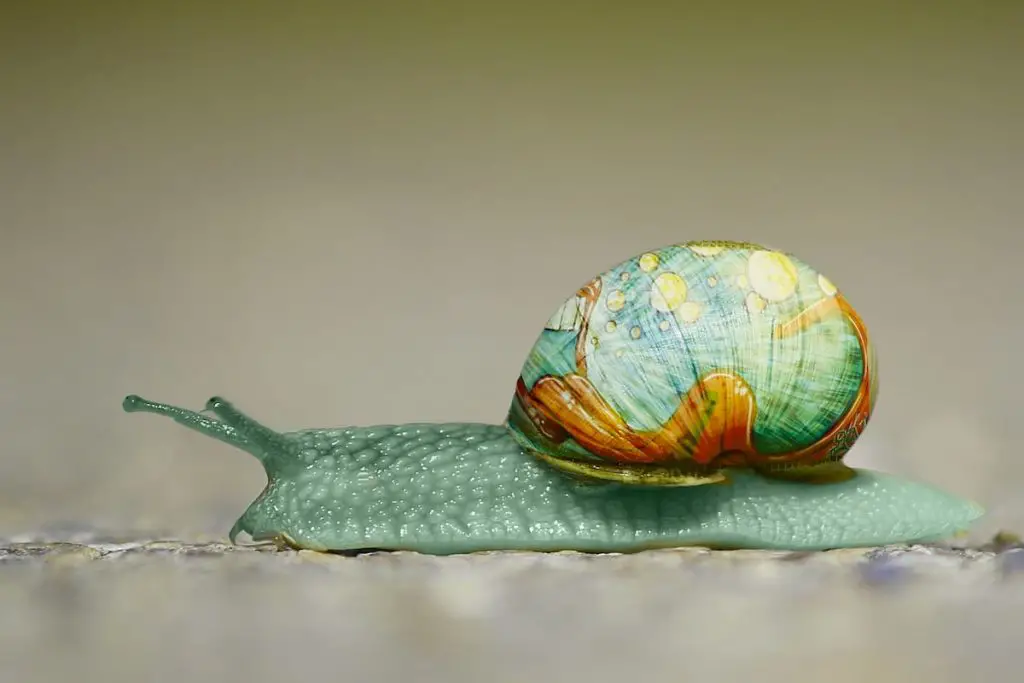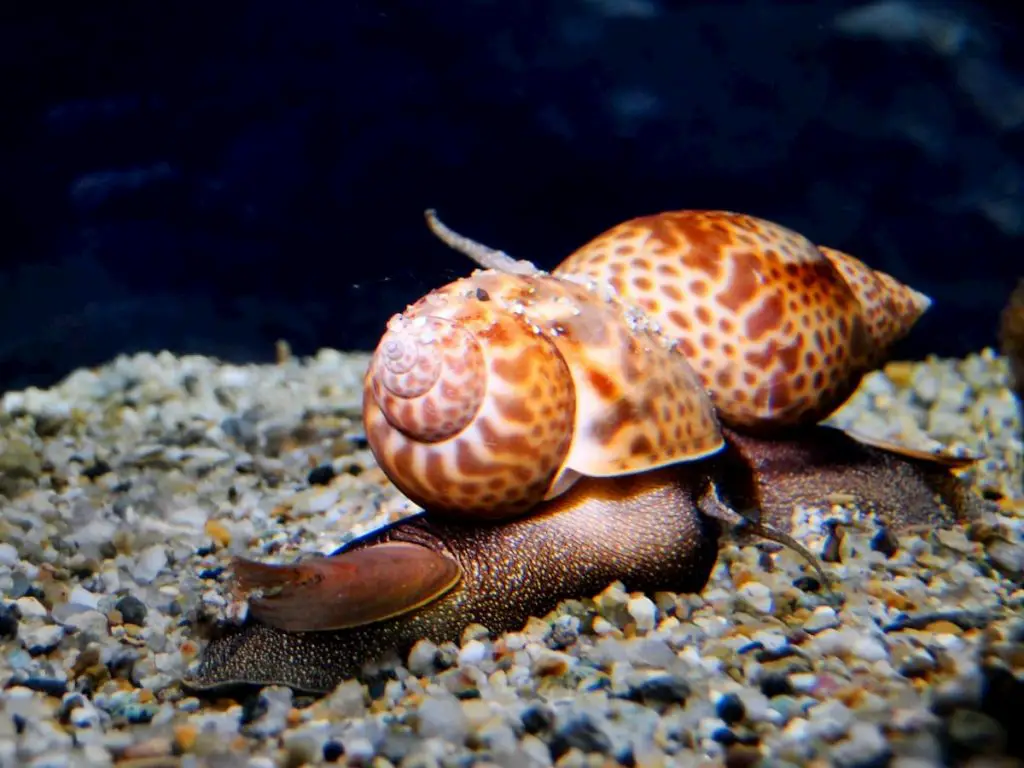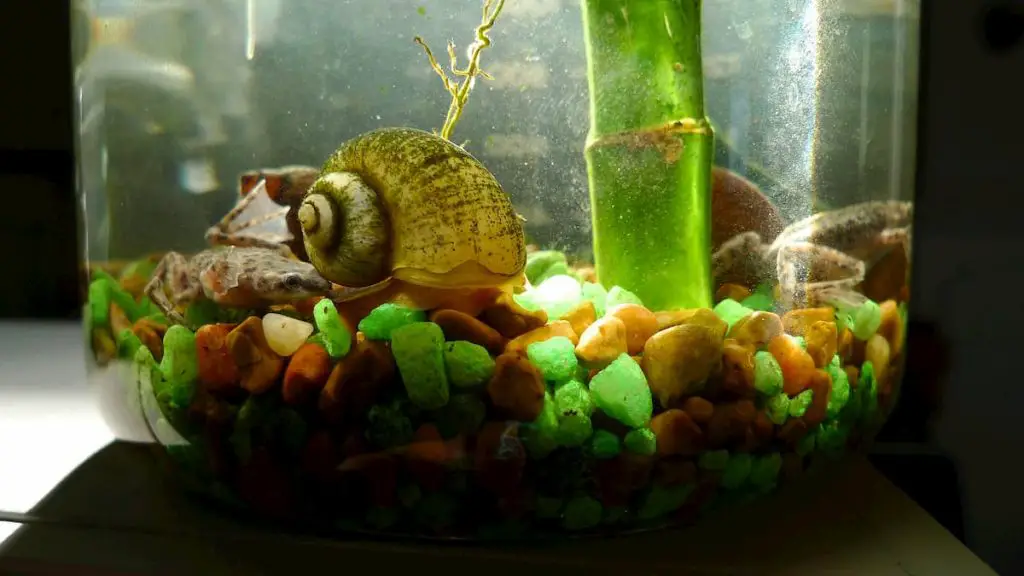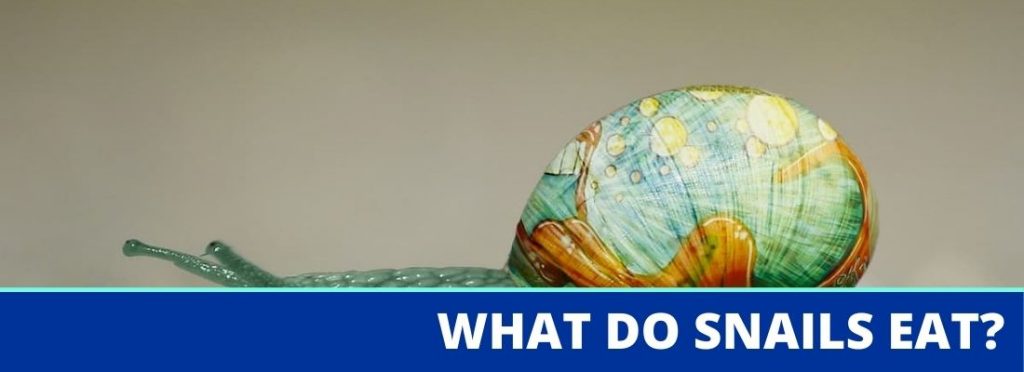So, we love these curly shelled little critters that inch their ways along the edge of a stone or through the sand at the bottom of our aquariums, but most of us don’t really know much about them.
In particular, the food they need and want is kind of a mystery. We know they eat – they have to. But are they herbivorous only? Or do some snails eat meat matter? Are some omnivores?
So, let’s take a look at what these little sluggish critters dine on, wherever they live and especially in our aquariums.
What Do Snails Eat in the Wild?

Snails and slugs are known as gastropods and belong to the same family called phylum Mollusca, or mollusks. While gastropods come in a variety of sizes and colors, they all share having shells and feet in common.
The way these creatures can eat is by using a tongue-like organ known as a radula. This organ has thousands of tiny little teeth which they use to scrape up plant matter and prey. Different species of snails have different dietary needs and can utilize their radula to aid in finding and eating food.
The best time to see garden snails is right after the rain or during overcast days. They love moisture and the moisture from rain will always almost draw them out. This is when garden snails can become a pest because they love to eat vegetation in gardens and farms. They will target seedlings, fruits, and thick-leaved plants, flowers, and tree bark. They are also known for eating dead plants and animal material, which helps with decomposition in food cycles.
Aquatic snails, like their land snail cousins, enjoy eating vegetation. This type of snail will eat both floating and submerged plants that are found in ponds, lakes, and rivers. In aquatic environments, including your aquarium pet snails can eat algae (like tadpoles) that grow over sediment and rocks. They can use their radulae to devour food.
There are types of carnivorous snails that will go after live prey. They will eat food like insects, worms, and smaller crustaceans. Depending on the circumstance, they are not averse to cannibalism and eat will eat other snails.
What Do Sea Snails Eat?

One of the more popular snails is the sea snail. These are well known because of their beautiful shells that are often collected on the shoreline. Abalones and cone snails are two of the most found sea snails.
Snails have strong shells by getting the calcium they need from consuming the shells of other marine animals, which sometimes means they eat other snails.
Sea snails are known as algal grazers and have no problem eating algae off reefs, sediment, and rocks. This grazing can also benefit your tank because their removal of the algae helps to keep things clean. If this snail type interests you, consider purchasing cowries, abalones, or limpets.
There are more aggressive snails that not only eat dead plants and animals but are predators. Sea snails like whelks, cones, and tritons will consume other invertebrates. Tritons are also known to be one of the few predators of the crown-of-thorns starfish, which is a notoriously dangerous predator that attacks coral reefs.
Another snail that is a predator is the oyster drill. This is a snail that uses its radula to create holes through the shell. Then it uses this hole to eat the oyster.
The best food for feeding your snail in an aquarium:
- Fish food that sinks slowly
- Alginate
- Calcium supplements
- Feeder snails
- Live clams
- Brine Shrimp
- Broken and crushed shells
- Algae
- Algae tablets
What Do Pond Snails Eat?
Pond snails have a similar diet to other snails. They have no issue with consuming plants, algae, or particles that have are suspended in the water.
When it comes to plants for your pond snails, you should consider plants such as bladderworts, duckweed, water lettuce and water hyacinth, and anacharis. The anacharis will help to encourage the growth of algae that snails like. The more algae you have in your tank, the happier your snails will be.
While pond snails are known to devour garden vegetables, their preference is for natural vegetation. It is possible to grow a small snail friendly garden along the water in your tank and then only offer garden vegetables as a supplement. The advantage of providing these extra plants is that there is no need to provide extra food for your snails. To keep your snails healthy and happy it is important to tend your tank and to replace any dead or dying plants.
If you have pond snails that are carnivores, you have several options for food. They will eat insect larvae, worms, insects and will even cannibalize other snails.
For snails that like vegetation:
- Large-leaf vegetation
- Flowers
- Cynao bacteria
- Benthic microalgae
- Naturally forming macroalgae
- Berries
- Berry leaves
- Lettuce
- Zucchini
- Kale
- Cucumbers
- Freshwater aquatic plants
For Carnivorous snails:
- Water Fleas
- Brine shrimp
- Feeder snails
- Blood worms
For omnivorous snails, all of the above variety of foods are possible meal choices for them.
What Do Aquarium Snails Eat?

The most common aquarium snails are freshwater. Snails of this type include mystery snails, apple snails, and nerites. Freshwater seas, similar to their cousin sea snails, are grazers. They will happily eat detritus, bacteria, and algae that that naturally forms on the substrate and rocks.
This love for plants can get snails into trouble and labeled as pests because of how much they love to eat crops and submerged vegetation. Other snails will use their mucus to capture and filter food particles from the water column.
To keep your aquarium snails to be healthy and happy, they need a continuous supply of plant life and algae. One of the benefits of having a well-stocked tank is that the snails will have a natural food source and feed themselves.
An easy way to feed snails that love vegetation is to use garden vegetables. They will eat a wide array of foods that include kale, cucumbers, lettuce, and zucchini. Before feeding these vegetables to your slugs, make sure that they are thoroughly washed and lightly blanched.
If you are concerned that your slugs are not getting enough nutrition there are supplements you can use that will help. There are calcium and protein tablets and food pellets that can sink at a slow rate and reach the bottom of your tank without being eaten by other animals. If your tank lacks algae you can always provide alginate or an algae supplement tablet for your snails.
If you decided to purchase carnivorous snails like the assassin snail, you must provide live prey. Some of the best choices for live food are small shrimp and bloodworms. Carnivorous slugs need to be given a steady supply of prey at least once or twice a day.
Good food choices for your freshwater aquarium snails include:
- Raw or cooked, blanched zucchini
- Raw or cooked, blanched cucumber
- Raw or cooked kale
- Raw or cooked lettuce
- Natural-forming macroalgae
- Submerged vegetation
- Slow-sinking fish pellets
- Cyanobacteria
- Alginate
- Benthic microalgae
- Algae tablets
- Commercial Snail Mixes
Land Snails
Land snails enjoy a diet that includes fungi, plants, and algae. In the wild, these snails will naturally congregate in grassy areas and fields. Food options that will make your land snail happy include plant matter and vegetables. These vegetables include dandelion greens, lettuce, carrots, and cucumbers. Individual snails have food preferences and you can experiment to see what they like the most. To feed your snails, place the plants in the tank and leave it for several days. If there are any leftovers, make sure to throw them away when they begin to rot.
Freshwater Snails
Freshwater snails have a diet that consists of decomposing plants and algae. Some breeds of these snails are even known to go after dead fish. These snails are great for keeping your aquarium clean but there is a downside. These snails are known for being able to multiply quickly and can overrun an aquarium if you do not pay close attention.
Sea Snails
Sea snails, which are also called marine nails, make their home in saltwater. They are like their freshwater cousins in that both love algae, plant matter, fish, invertebrates, and other types of animal matter. Some types of snails will scavenge and eat anything they find.
If you decide that you want carnivorous snails, it’s important to keep a stock of prey. Likewise, if you choose to have plant-eating snails, make sure that your aquarium has a steady supply of algae to eat.
Breeding Considerations For Diet
Unless there are predators, snails will naturally mate and multiply. If you want a natural way to keep your snail population in check, keep fish who eat snails. If you have a terrarium, you can give away the extra snails or release them into the wild.
Diet Consideration of Specific Snail Species
Just like other critters you keep, specific species of snails have special dietary considerations to keep in mind.

What Do Nerite Snails Eat?
If your tank is having an algae issue, Nerite snails are a great choice. This type of snail is known for their love of eating up algae that form on the surface of aquariums. If these efficient algae eaters run out of food to eat, they are also known to eat cooked vegetables like zucchini or lettuce.
This type of snail comes in both marine and freshwater varieties. Make sure to check on the breed you are purchasing because some specialize in eating only certain kinds of algae.
What Do Apple Snails Eat?
The main food that apple snails consume is aquatic plants. Apple snails are voracious eaters known for eating large amounts of food and can destroy crops of taro and rice. They feed on living or dead plant matter as well as microbe colonies and algae. Appel snails are native to South America but have become an invasive species in some US states and Asian countries due to their popular use in aquariums.
What Do Mystery Snails Eat?
Mystery snails are known for being efficient algae cleaners. They have a strong appetite and clean up the surface and benthic algae. If there are not enough algae to eat they can consume algae tablets and alginate supplements. One great thing about mystery snails is that they will not attack or damage your aquarium plants.
How Should You Feed Your Aquarium Snails?
Depending on the species of snails you keep, you’ll need to feed them a combination of vegetable matter and fish food. You should do so at night. They’re more active when the lights are out, so they’ll benefit most from being fed at night.
If you see any food is leftover in the morning, decrease the amount you feed to them the next time. If they start eating your plants or eat all the food quickly, increase the food little by little until they stop doing so.
